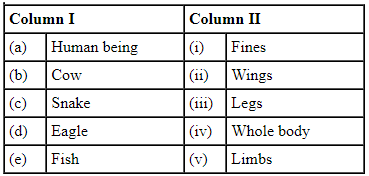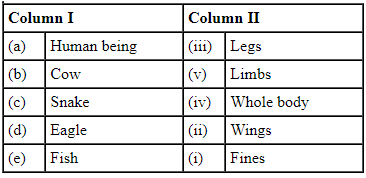NCERT Exemplar Solutions: Body Movements | Science Olympiad Class 6 PDF Download
| Table of contents |

|
| Multiple Choice Questions |

|
| Very Short Answer Questions |

|
| Short Answer Questions |

|
| Long Answer Questions |

|
Multiple Choice Questions
Q1: Which of the following parts of our body help us in movement?
(i) Bones
(ii) Skin
(iii) Muscles
(iv) Organs
choose the correct answer from the option below.
(a) (i) and (iii)
(b) (ii) and (iv)
(c) (i) and (iv)
(d) (ii) and (iii)
 View Answer
View Answer 
Ans: (a)
Bones form the structural framework of a body called a skeleton. The skeleton along with muscles helps our body parts to move. Bones are hard and cannot bend on their own. The joints help the body in moving.
Muscles are like elastic bands which are attached to the bones by means of tough connecting bands called tendons. Muscles help in the movement of bone through pull/contraction. Bones are wrapped up by muscles.
Q2: Which of the following joints is immovable?
(a) Shoulder and arm
(b) Knee and joint
(c) Upper jaw and skull
(d) The lower jaw and upper jaw
 View Answer
View Answer 
Ans: (c)
Upper jaw and skull have immovable joints since they are fixed joints.
Q3: Which of the following organisms does not have both muscles and skeleton for movement?
(a) Dog
(b) Snail
(c) Earthworm
(d) Human being
(e) None of the above
 View Answer
View Answer 
Ans: (e)
Human beings and dogs have endoskeleton and muscles.
Snails have exoskeleton and muscles.
Earthworm does not have a skeleton. It has two sets of muscles one that makes it long and thin and the other that makes it fat. The contraction and relaxation of these muscles help in movement.
Q4: Underwater divers wear fin-like flippers on their feet to
(a) swim easily in water
(b) look like a fish
(c) walk on the water surface
(d) walk over the bottom of the sea (sea bed).
 View Answer
View Answer 
Ans: (a)
Divers while swimming wears fin-like flippers on their feet because the muscle in the feet contracts, generating a curve on one side like a wave and the fin-like flippers move on the opposite direction exerting force against the surrounding water that pushes the underwater divers forward.
Q5: A snail moves with the help of its
(a) shell
(b) bone
(c) muscular foot
(d) whole body.
 View Answer
View Answer 
Ans: (c)
The muscular foot of the snail comes outside and attaches to the ground during locomotion. The foot of a snail has a special gland that produces slimy mucus to make slippery track to help it move smoothly.
Q6: How many muscles work together to move a bone?
(a) One
(b) Two
(c) Three
(d) Four
 View Answer
View Answer 
Ans: (b)
Very Short Answer Questions
Q7: Name the type of joint of your hand which helps you to grasp a badminton racquet.
 View Answer
View Answer 
Hinge joints present in our fingers help us to grasp the things like badminton racquet.
Q8: What would have happened if our backbone was made of one single bone?
 View Answer
View Answer 
If our backbone was made of one single bone we would not have been able to bend and twist our back.
Q9: Provide one-word answers to the statements given below.
1. A joint which allows movement in all directions.
2. A hard structure that forms the skeleton.
3. Part of the body with a fixed joint.
4. Help in the movement of the body by contraction and relaxation.
5. Bones that join with chest bone at one end and to the backbone at the other end.
6. A framework of bones which gives shape to our body.
7. Bones which enclose the organs of our body that lie below the abdomen.
8. Joint where our neck joins the head.
9. Part of the skeleton that forms the earlobe.
 View Answer
View Answer 
Here are the one-word answers:
1. Ball and socket joint
2. Bone
3. Upper jaw with the skull
4. Muscles
5. Ribs
6. Skeleton
7. Pelvic bones
8. Pivotal joint
9. Cartilage
Q10: Write the type of joint which is used for each of the following movements.
(a) A cricket bowler bowls the ball.
(b) A girl moves her head in right and left direction.
(c) A person lifts weights to build up his biceps.
 View Answer
View Answer 
(a) Hinge joint and ball and socket joint
(b) Pivotal joint
(c) Hinge joint
Short Answer Questions
Q11: Match the name of the animals given in Column I with its body parts used for movement given in Column II.
 View Answer
View Answer 
Here is the correct match:

Q12: Given below is a list of different types of movements in animals.
[Running, Jumping, Walking, Slithering, Crawling, Flying, Swimming, Creeping] Write the types of movements seen in each animal.
(a) Duck
(b) Horse
(c) Kangaroo
(d) Snail
(e) Snake
(f) Fish
(g) Human beings
(h) Cockroach
 View Answer
View Answer 
(b) Horse – Running, Walking
(c) Kangaroo – Jumping
(d) Snail – Creeping, Crawling
(e) Snake – Slithering
(f) Fish – Swimming
(g) Human beings – Walking, Running, Jumping, Swimming, Crawling
(h) Cockroach – Walking, Flying, Running
Q13: Boojho fell off a tree and hurt his ankle. On examination, the doctor confirmed that the ankle was fractured. How was it detected?
 View Answer
View Answer 
A doctor must have detected a swelling in the injured area and taken an X-ray of the ankle. By using X-ray technique, images show the desired part of the bones in our body. By looking at the x-ray, the doctor could have confirmed a fracture in the ankle.
Q14: Bones are hard structures and cannot be bent. But, we can still bend our elbow, knee, etc. How is this possible?
 View Answer
View Answer 
Due to the presence of different types of joints between the bones we are able to bend our body parts such as elbow, knee, back etc.
Elbow and knee are not made up of a single bone but two or more bones which are joined to each other by a hinge joint. This joint along with the muscles help us to bend the elbow and knee.Q15: Which type of movement would have been possible if
(a) our elbow had a fixed joint?
(b) we were to have a ball and socket joint between our neck and head.
 View Answer
View Answer 
(b) We would be able to rotate our head in all directions i.e., at 360°.
Q16: Earthworms are known as ‘farmer’s friends’. Why?
 View Answer
View Answer 
Earthworms are called ‘farmer’s friends’ because they improve the texture and quality of the soil. By burrowing into the soil, they make the soil loose, thus allowing air to pass through it and water to drain from it. It gets easier for soil to breathe. Earthworms also increase soil fertility by excreting the undigested materials into the soil.
Long Answer Questions
Q17: (a) Unscramble the jumbled words and write them in the blank spaces provided.
(i) neosb ______.
(ii) tnemevom ______.
(iii) iontcaronct ______.
(iv) lsecsum ______.
(v) arctigeal ______.
(vi) epahs ______.
(vii) sangro inerlant ______.
(viii) laxaeriont ______.
(b) Read the following paragraph and fill in the blanks using the words you unscrambled.
______(a) and ______(b) form the skeleton of the human body. They provide the framework, give (c) ______to the body and help in (d) ______They protect the (e) ______The bones are moved by alternate (f) ______and (g) ______of two sets of (h) ______ attached to them.
 View Answer
View Answer 
Here are the correct words:
(a) (i) Bones
(ii) movement
(iii) Contraction
(iv) Muscles
(v) Cartilage
(vi) Shape
(vii) Internal organs
(viii) Relaxation
(b) (a) Bones
(b) Cartilage
(c) shape
(d) movement
(e) Internal organs
(f) Contraction
(g) Relaxation
(h) Muscles
Q18: How is the skeleton of a bird well-suited for flying?
 View Answer
View Answer 
Following features make the skeleton of a bird well – suited for flying:
(i) Bones are hollow and light.
(ii) The shape of the body is streamlined which helps to move easily in air.
(iii) Bones of hind limbs are specialized for walking, hopping and perching.
(iv) Bones of forelimbs are modified into wings for flight.
(v) Breastbones hold flight muscles and are used to move the wings up and down.
(vi) Shoulder bones are strong.
Q19: In Fig. 8.2 there are two snakes of the same size slithering on the sand. Can you identify which of them would move faster and why?
 View Answer
View Answer 
|
70 videos|150 docs|104 tests
|
FAQs on NCERT Exemplar Solutions: Body Movements - Science Olympiad Class 6
| 1. What are the different types of movements in the human body? |  |
| 2. How do joints facilitate body movements? |  |
| 3. What is the significance of skeletal muscles in body movements? |  |
| 4. Can you explain the difference between voluntary and involuntary movements? |  |
| 5. What role does the spine play in body movements? |  |





















